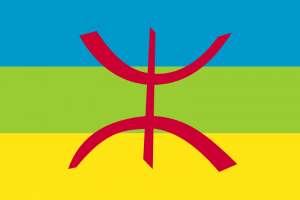Language/Standard-moroccan-tamazight/Grammar/Possessive-Adjectives
| ◀️ Present Tense Verbs — Previous Lesson | Next Lesson — Plural Nouns ▶️ |
Welcome to our lesson on Possessive Adjectives in Standard Moroccan Tamazight! In this segment, we’ll dive into a fundamental aspect of the language that allows you to express ownership and relationships. Understanding possessive adjectives is crucial as they enable you to describe things that belong to someone or something, enriching your conversations and making your communication more effective.
Why Are Possessive Adjectives Important?
Possessive adjectives are essential in any language because they provide clarity and context. In Tamazight, they help you articulate who owns what, which is vital whether you're talking about family, objects, or places. For example, knowing how to say "my book" or "his house" will allow you to engage in everyday conversations more comfortably.
Structure of the Lesson
In this lesson, we will cover the following topics:
- What are Possessive Adjectives?
- List of Possessive Adjectives in Tamazight
- Examples of Possessive Adjectives in Sentences
- Practice Exercises
- Solutions and Explanations
Let's jump right in!
What are Possessive Adjectives?
Possessive adjectives are words that show ownership. In Standard Moroccan Tamazight, these adjectives change depending on the subject (the person who possesses something). The structure is typically simple, where the adjective precedes the noun.
List of Possessive Adjectives in Tamazight
Here’s a table that outlines the possessive adjectives in Standard Moroccan Tamazight:
| Standard Moroccan Tamazight | Pronunciation | English |
|---|---|---|
| ⴰⵎⴻⵏ | amɛn | my |
| ⴰⵣⵓⴳ | azuɣ | your (singular) |
| ⴰⵎⴰⵔ | amar | his |
| ⴰⵎⴰⵔⴻ | amari | her |
| ⴰⵎⴼⴰ | amfa | our |
| ⴰⵣⵓⴳⴻ | azuge | your (plural) |
| ⴰⵎⴰⵏ | aman | their |
Examples of Possessive Adjectives in Sentences
To better understand how to use possessive adjectives, let's look at some examples in context.
| Standard Moroccan Tamazight | Pronunciation | English |
|---|---|---|
| ⴰⵎⴻⵏ ⴰⵏⵙⴰ | amɛn ansa | my book |
| ⴰⵣⵓⴳ ⴰⵏⵙⴰ | azuɣ ansa | your book (singular) |
| ⴰⵎⴰⵔ ⴰⵏⵙⴰ | amar ansa | his book |
| ⴰⵎⴰⵔⴻ ⴰⵏⵙⴰ | amari ansa | her book |
| ⴰⵎⴼⴰ ⴰⵏⵙⴰ | amfa ansa | our book |
| ⴰⵣⵓⴳⴻ ⴰⵏⵙⴰ | azuge ansa | your book (plural) |
| ⴰⵎⴰⵏ ⴰⵏⵙⴰ | aman ansa | their book |
Forming Sentences with Possessive Adjectives
When constructing sentences with possessive adjectives, remember:
- The possessive adjective comes before the noun.
- The noun remains in its base form.
Here are more sentences using possessive adjectives:
1. My house: ⴰⵎⴻⵏ ⴰⵡⵓⵏ (amɛn awun) - my house
2. Your (singular) car: ⴰⵣⵓⴳ ⴰⵎⴰⵣⵉ || azuɣ amzi || your car
3. His friend: ⴰⵎⴰⵔ ⴰⵎⴰⵍⴰ || amar amala || his friend
4. Her pen: ⴰⵎⴰⵔⴻ ⴰⵎⴰⵍⴰ || amari amala || her pen
5. Our teacher: ⴰⵎⴼⴰ ⴰⵏⴳⴰ || amfa anɡa || our teacher
6. Your (plural) dog: ⴰⵣⵓⴳⴻ ⴰⵡⵓⴷ || azuge awud || your dog (plural)
7. Their garden: ⴰⵎⴰⵏ ⴰⴳⴰⵏ || aman aɡan || their garden
Practice Exercises
Now that we've covered the basics, let's put your knowledge to the test with some practice exercises! Try to fill in the blanks or translate the sentences using the correct possessive adjective.
1. Fill in the blank: ⴰⵎⴻⵏ ___ (my) ___ (book).
2. Translate: "her sister" into Tamazight.
3. Fill in the blank: ___ (your - plural) ___ (car).
4. Translate: "our friend" into Tamazight.
5. Fill in the blank: ___ (his) ___ (house).
6. Translate: "my pen" into Tamazight.
7. Fill in the blank: ___ (your - singular) ___ (dog).
8. Translate: "their garden" into Tamazight.
9. Fill in the blank: ___ (her) ___ (book).
10. Translate: "our teacher" into Tamazight.
Solutions and Explanations
Now let’s go through the solutions to the exercises we just completed:
1. Solution: ⴰⵎⴻⵏ ⴰⵏⵙⴰ (amɛn ansa) - my book.
2. Solution: ⴰⵎⴰⵔⴻ ⴰⵏⵙⴰ (amari ansa) - her sister.
3. Solution: ⴰⵣⵓⴳⴻ ⴰⵎⴰⵣⵉ (azuge amzi) - your car (plural).
4. Solution: ⴰⵎⴼⴰ ⴰⵎⴰⵍⴰ (amfa amala) - our friend.
5. Solution: ⴰⵎⴰⵔ ⴰⵡⵓⵏ (amar awun) - his house.
6. Solution: ⴰⵎⴻⵏ ⴰⵎⴰⵍⴰ (amɛn amala) - my pen.
7. Solution: ⴰⵣⵓⴳ ⴰⵡⵓⴷ (azuɣ awud) - your dog (singular).
8. Solution: ⴰⵎⴰⵏ ⴰⴳⴰⵏ (aman aɡan) - their garden.
9. Solution: ⴰⵎⴰⵔⴻ ⴰⵏⵙⴰ (amari ansa) - her book.
10. Solution: ⴰⵎⴼⴰ ⴰⵏⴳⴰ (amfa anɡa) - our teacher.
Conclusion
Congratulations! You’ve successfully learned how to use possessive adjectives in Standard Moroccan Tamazight. With practice, you’ll find that describing ownership becomes second nature, allowing you to express yourself more freely and accurately.
As you continue your journey through the Complete 0 to A1 Standard Moroccan Tamazight Course, remember to revisit this lesson whenever you need a refresher. The next chapter will take us through Plural Nouns, where we will expand our vocabulary even further. Keep up the great work!
Other Lessons
- How to Use Be
- Verb to be
- Regular Future Tense Verbs
- Future Tense
- Possessive pronouns
- Present Tense Verbs
- Adjectives
- Irregular Future Tense Verbs
- Questions
- How to Use Have
| ◀️ Present Tense Verbs — Previous Lesson | Next Lesson — Plural Nouns ▶️ |

